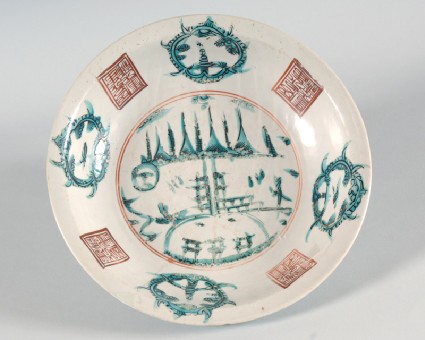Browse: 242 objects
Zhangzhou ware dish with 'split-pagoda' pattern
- loan
-
Details
- Associated place
-
Asia › China › Fujian province › Zhangzhou kilns (place of creation)
- Date
-
16th - 17th century (1501 - 1700)
Ming Dynasty (1368 - 1644)
- Material and technique
- porcelain, thrown, with black, turquoise, and red overglaze enamels
- Dimensions
-
8.8 cm (height)
38 cm (diameter)
at foot 19.7 cm (diameter)
- Material index
- Technique index
- Object type index
- No. of items
- 1
- Credit line
- Lent by the Sir Alan Barlow Collection Trust.
- Accession no.
- LI1301.394
-
Further reading
University of Sussex, and Arts and Humanities Research Council, The Barlow Collection, supervised by Regina Krahl, Maurice Howard, and Aiden Leeves (Sussex: University of Sussex, 2006), no. C394
Glossary
porcelain
-
porcelain
Ceramic material composed of kaolin, quartz, and feldspar which is fired to a temperature of c.1350-1400⁰c. The resulting ceramic is vitreous, translucent, and white in colour.
Location
-
- currently in research collection
Objects are sometimes moved to a different location. Our object location data is usually updated on a monthly basis. Contact the Jameel Study Centre if you are planning to visit the museum to see a particular object on display, or would like to arrange an appointment to see an object in our reserve collections.
Publications online
-

The Barlow Collection
The motif depicted on this dish is known as the ‘split pagoda’, but its meaning has not yet been elucidated. Dishes of this general type are usually called ‘Swatow’ wares after the port city of Shantou in Guangdong province, close to the border with Fujian. Wares of this general type have been discovered at Zhangzhou in Fujian, but no dishes of the ‘split pagoda’ design appear so far to have come to light at that site.
The dish has wide rounded sides and an everted rim, and rests on a tapering foot. The inside is painted with a landscape scene in black outlines and turquoise washes, with a steep mountain range under a sun and clouds, with a pagoda, apparently split in two, and a lake in front with three pavilion-like gates, all surrounded by two red lines. The sides show three lobed roundels with further pagodas among rudimentary branches, and four red seals of debased Chinese script, written to be read from the rim. The outside is plain and shows the opaque white glaze which has been applied in several layers, with much grit adhering around the foot.
© 2013 University of Oxford - Ashmolean Museum



